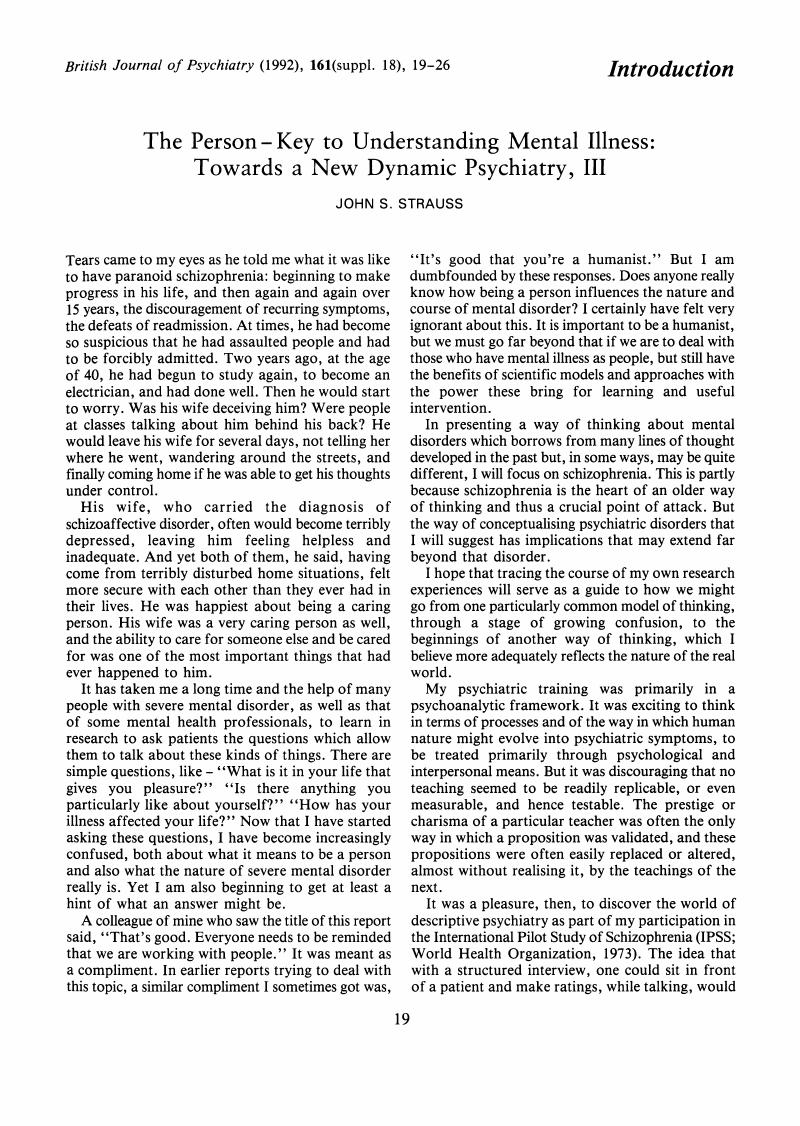Crossref Citations
This article has been cited by the following publications. This list is generated based on data provided by Crossref.
Gilbert, Sidsel
and
Ugelstad, Endre
1994.
Patients' Own Contributions to Long-Term Supportive Psychotherapy in Schizophrenic Disorders.
British Journal of Psychiatry,
Vol. 164,
Issue. S23,
p.
84.
Edgerton, Robert B.
and
Cohen, Alex
1994.
Culture and Schizophrenia: the DOSMD Challenge.
British Journal of Psychiatry,
Vol. 164,
Issue. 2,
p.
222.
Hoff, Paul
1994.
Emil Kraepelin und die Psychiatrie als klinische Wissenschaft.
Vol. 73,
Issue. ,
p.
215.
Hydén, Lars-Christer
1995.
Lars-Christer Hyden.
Journal of Narrative and Life History,
Vol. 5,
Issue. 1,
p.
67.
Mezzich, Juan E.
1995.
Cultural Formulation and Comprehensive Diagnosis.
Psychiatric Clinics of North America,
Vol. 18,
Issue. 3,
p.
649.
Trijsburg, R. W.
1995.
Psychotherapie bij specifieke, psychiatrische ziektebeelden.
Tijdschrift voor Psychotherapie,
Vol. 21,
Issue. 6,
p.
295.
Shera, Wes
and
Delva-Tauiliili, Jorge
1996.
Changing MSW students' attitudes towards the severely mentally Ill.
Community Mental Health Journal,
Vol. 32,
Issue. 2,
p.
159.
Teague, Gregory B.
Ganju, Vijay
Hornik, John A.
Johnson, J. Rock
and
McKinney, Jacki
1997.
The MHSIP Mental Health Report Card.
Evaluation Review,
Vol. 21,
Issue. 3,
p.
330.
Palmer-Erbs, Victoria K
and
Unger, Karen V
1997.
An Innovation in Psychiatric Rehabilitation Programming: Supported Education.
Journal of Psychosocial Nursing and Mental Health Services,
Vol. 35,
Issue. 1,
p.
16.
BECK-SANDER, ALISON
1998.
I sinsight into psychosismeaningful?.
Journal of Mental Health,
Vol. 7,
Issue. 1,
p.
25.
Jenkins, Janis Hunter
and
Cofresi, Norma
1998.
The Sociosomatic Course of Depression and Trauma.
Psychosomatic Medicine,
Vol. 60,
Issue. 4,
p.
439.
Albiston, Dianne J.
Francey, Shona M.
and
Harrigan, Susan M.
1998.
Group programmes for recovery from early psychosis.
British Journal of Psychiatry,
Vol. 172,
Issue. S33,
p.
117.
MEZZICH, JUAN E.
KIRMAYER, LAURENCE J.
KLEINMAN, ARTHUR
FABREGA, HORACIO
PARRON, DELORES L.
GOOD, BYRON J.
LIN, KEH-MING
and
MANSON, SPERO M.
1999.
The Place of Culture in DSM-IV.
The Journal of Nervous & Mental Disease,
Vol. 187,
Issue. 8,
p.
457.
Roe, David
and
Ben-Yishai, Ayelet
1999.
Exploring the Relationship between the Person and the Disorder among Individuals Hospitalized for Psychosis.
Psychiatry,
Vol. 62,
Issue. 4,
p.
370.
ROE, DAVID
2001.
Progressing from Patienthood to Personhood across the Multidimensional Outcomes in Schizophrenia and Related Disorders.
The Journal of Nervous and Mental Disease,
Vol. 189,
Issue. 10,
p.
691.
Hyde, Paula
2001.
Support Groups for People Who Have Experienced Psychosis.
British Journal of Occupational Therapy,
Vol. 64,
Issue. 4,
p.
169.
Bassman, Ronald
2001.
Whose Reality is it Anyway? Consumers/Survivors/Ex-Patients Can Speak for Themselves.
Journal of Humanistic Psychology,
Vol. 41,
Issue. 4,
p.
11.
Williams, Charmaine C.
and
Collins, April A.
2002.
The Social Construction of Disability in Schizophrenia.
Qualitative Health Research,
Vol. 12,
Issue. 3,
p.
297.
Yip, Kam-shing
2003.
Traditional Chinese Religious Beliefs and Superstitions in Delusions and Hallucinations of Chinese Schizophrenic Patients.
International Journal of Social Psychiatry,
Vol. 49,
Issue. 2,
p.
97.
Roe, David
and
Chopra, Miriam
2003.
Beyond coping with mental illness: Toward personal growth..
American Journal of Orthopsychiatry,
Vol. 73,
Issue. 3,
p.
334.






eLetters
No eLetters have been published for this article.